“], “filter”: { “nextExceptions”: “img, blockquote, div”, “nextContainsExceptions”: “img, blockquote, a.btn, a.o-button”} }”>
Given the headlines and holidays and flu and frenzy and annoyingly long, dark nights we’re all experiencing lately, it can be easy to consider a Yin Yoga practice of quiet surrender to be the last thing you have the time or patience to try.
That’s how you know Yin Yoga is exactly what you need.
Yin Yoga asks you to toe the line with your threshold for intensity and remain there, without flinching or shrinking or forcing yourself past it, in stillness and quiet acceptance.
For must of us, the physical practice is the easy part. The true challenge of Yin isn’t the actual stretch. It’s the sitting still part. With that comes learning to quiet your thoughts and not create even more resistance to what’s happening—or not happening—in your current circumstances, in both your body or your mind. That’s the true takeaway of this seemingly simple, though not easy, practice.
What you take away from Yin is the psychological steadiness to make it through the challenge of each unexpected or unwanted moment in life. At this time of year, with darkness encroaching on our days and despondency not far behind, we have the option to succumb to overwhelm or we can pause and come back to ourselves to fortify before facing another moment. This is mirrored in the traditions behind the winter solstice on December 21, which marks the longest night of the year. As we sit in stillness and acceptance of what is, we allow space for all that is yet to be.
Sukhasana (Easy Seat)
Start in a comfortable, cross-legged Easy Seat. Take several long and relaxed breaths. Close your eyes and allow yourself to settle into the present moment. Once you have arrived and feel centered, let’s begin.
See also Why Try Yin Yoga?
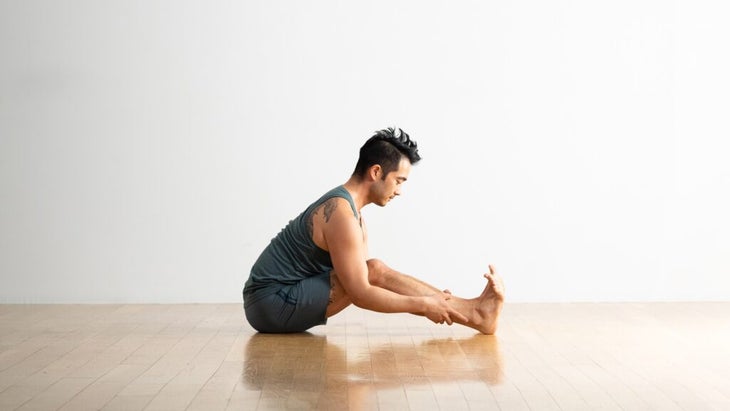
Caterpillar
From sitting cross-legged, extend your legs straight in front of you with your feet together or hip-distance apart. If you experience tightness along the backs of your legs or your lower-back, you can keep your knees bent, slide a rolled blanket beneath your knees, or sit on the edge of a folded blanket. Start to lean forward, hinging at your hips to tilt your pelvis forward. Walk your hands forward until you reach your first sign of tension. You can stay here or allow your back to round and bow your head forward to invite a deep stretch through the upper back, shoulders, and neck. Breathe into the back of your body, with a special focus on the low back and legs. Relax your legs and find stillness. Breathe here for about 3 minutes.
To come out of the pose, walk your hands in and press up to an upright seat.
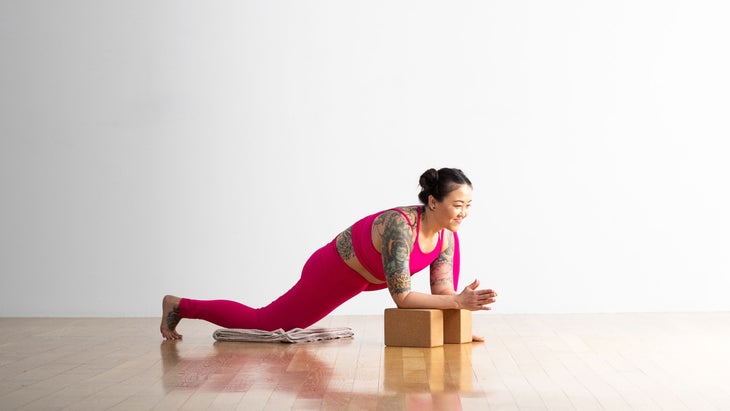
Dragon Lunge
From sitting, make your way to hands and knees with your shoulders stacked over your wrists. Bring your left foot outside your left hand. Keep your hands beneath your shoulders on the mat or on blocks. Allow your hips to settle toward the mat and your chest to extend forward. Stay here or, if it feels appropriate to intensify the stretch, lower onto your forearms. Breathe here for about 3 minutes.
To come out of the pose, shift your hips back into hands and knees. Don’t forget to do the other side.
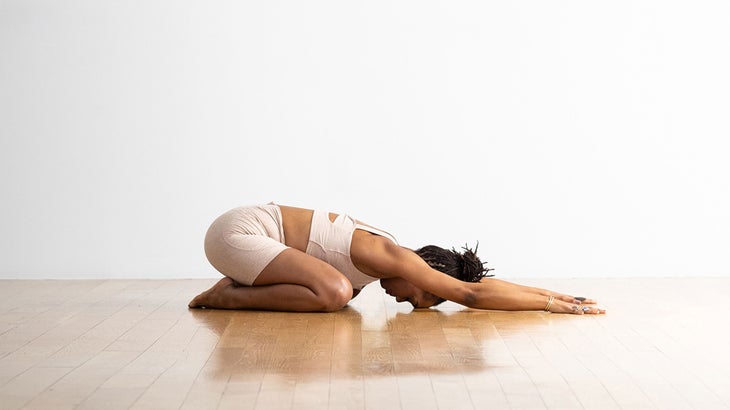
Child’s Pose
From hands and knees, bring your knees wider than your hips and sink your hips toward your heels. (If your bum doesn’t touch your heels, you can slide a rolled blanket between your heels and bum for support.) Find a comfortable arm position, whether you extend your arms forward or release them alongside your body. Relax your neck and shoulders. Take a long exhale and find stillness. Breathe here for about 3 minutes.
To come out of the pose, press into your hands and come back to hands and knees.
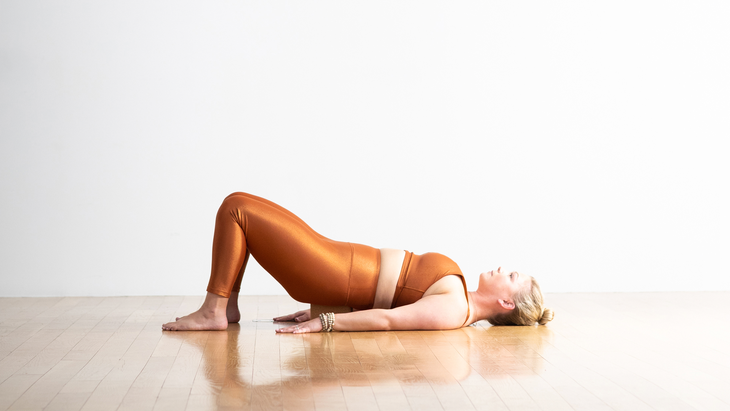
Supported Bridge
Lie on your back with a block, bolster, or a couple firm pillows within reach. Bend your knees and walk your feet toward you. Press into your feet to lift your hips and slide the block or other support under your sacrum, which is the lowest part of your spine. Allow your weight to release into the prop. Make any adjustments so you find a comfortable position. Rest your arms alongside your body, palms up or down. Stay here or straighten your legs so your heels move toward the far corners of the mat. If that feels too deep, come back to bent knees or try extending one leg at a time. Breathe here for about 3 minutes.
To come out of the pose, draw your hands by your side and walk your feet back in if your legs were straight. Press into your feet to lift your hips, slide the prop to the side, and slowly set your hips back down on your mat. Take a moment to check in and ask what would feel good for your body right now and do that. Sometimes, drawing your knees into the chest feels instinctive but other times extending your legs in Savasana seems more fitting. Listen to your body.
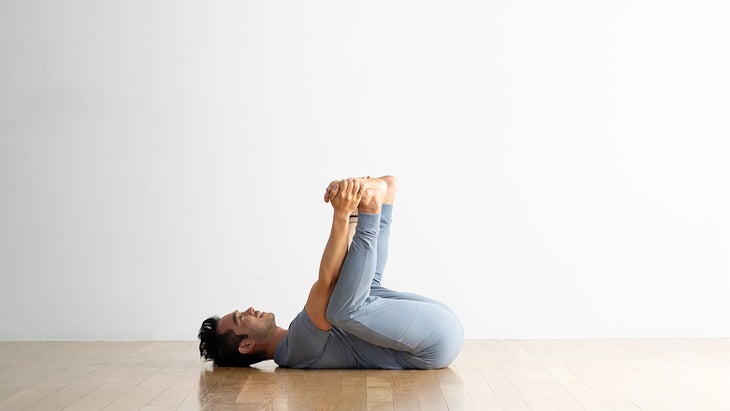
Happy Baby or Knees-to-Chest Pose
From lying on your back, draw your knees into your chest and hold onto your shins or the backs of your thighs. Do what feels good in your body, perhaps slowly rocking from side to side or making small circles with your lower back. Come back to stillness and stay here or move into Happy Baby by bringing your ankles over your knees and allowing your knees to fall wide. Bring your hands to the outer edges of your feet or on your calves. Stay here for 1-2 minutes or as long as you need.
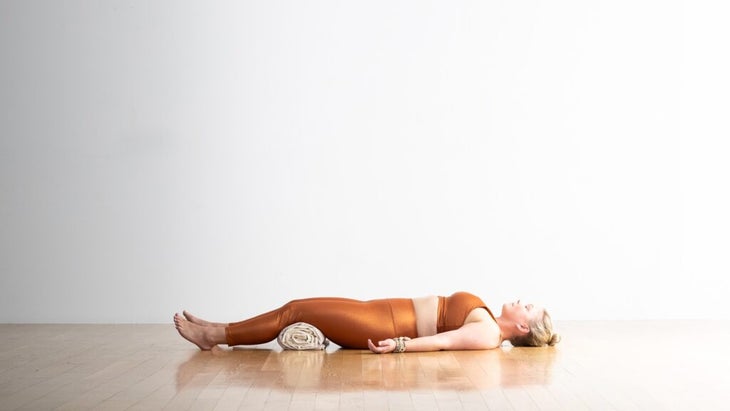
Savasana
From Happy Baby, lower your legs to the mat and give yourself any support that you need to feel comfortable, such as a rolled blanket beneath your knees. Come into stillness, release any lingering sensations from your practice, and surrender the weight of your body. Stay here as long as you need.
This article has been updated. Originally published December 20, 2016.
About our contributor
Dani March is a Toronto-based yoga and meditation teacher.

